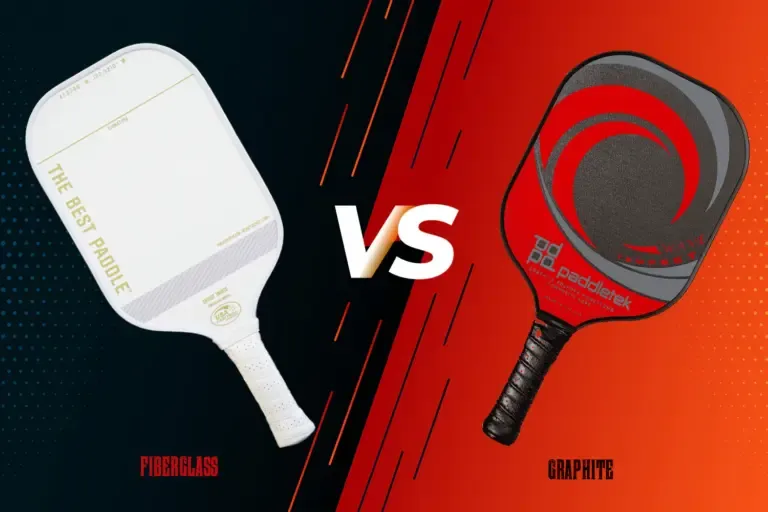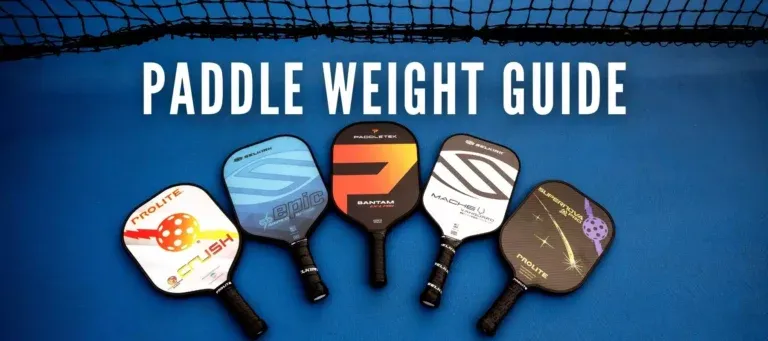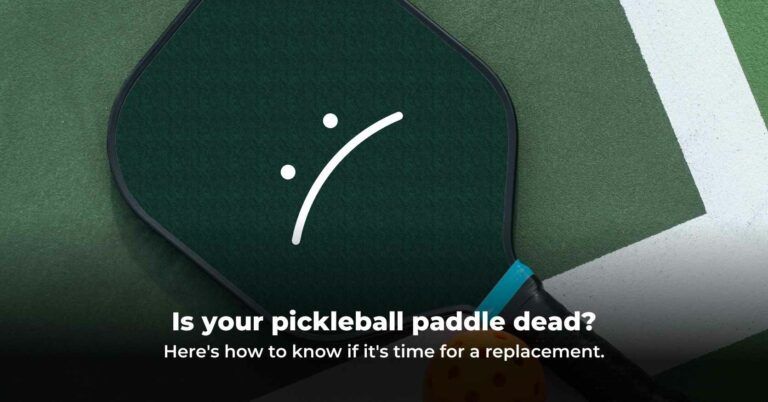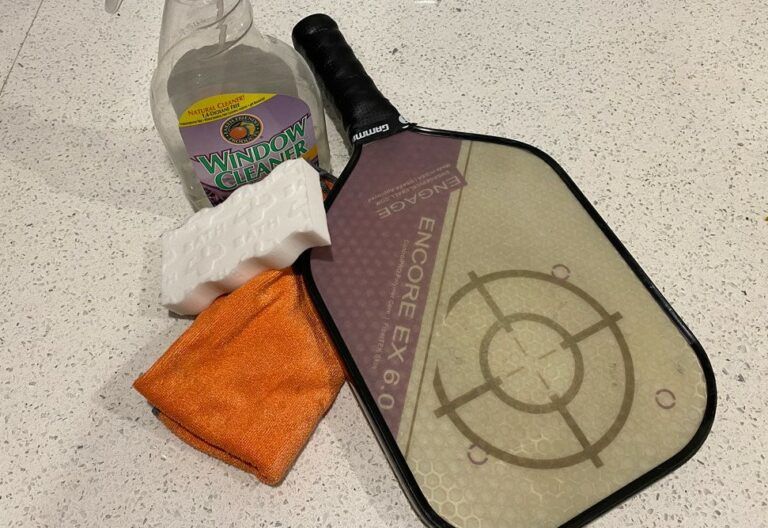Understanding the Basics: Graphite vs Fiberglass pickleball paddles
What is a Graphite Pickleball Paddle?
Graphite paddles are made from crystalline carbon, a material that imparts exceptional advantages to players. The unique construction of these paddles often consists of thin layers, giving them a lightweight profile typically ranging from 7 to 8.5 ounces.
This makes them particularly inviting for players seeking swift maneuverability on the court. The rigidity associated with graphite is another significant property, offering players remarkable control over their shots while simultaneously enabling powerful strikes. It becomes evident that these characteristics serve to enhance the gameplay of those who prioritize finesse and accuracy.
However, one should be wary of their longevity in tough conditions. Although graphite paddles are durable, they can be more susceptible to wear and tear from abrasive surfaces compared to their fiberglass counterparts. The thin construction serves well for generating powerful shots, but it can also mean that the paddles may wear out faster when subjected to rough handling or frequent use on unforgiving courts.

What is a Fiberglass Pickleball Paddle?
Contrasting sharply with graphite, fiberglass paddles are generally composed of a glass fiber composite. This flexibility becomes a unique selling point of fiberglass paddles, allowing players to manipulate shot trajectories more efficiently. The weight of these paddles, typically between 6.5 to 8 ounces, means they can hit with considerable power due to their increased mass. While this added weight may impact the speed of play slightly, it can also offer a whole new level of strength for aggressive shots.
Moreover, fiberglass paddles usually feature a rougher surface texture, which is beneficial for players looking to add spin to their ball. This quality makes them an excellent choice for those who wish to explore their shot capabilities fully. While durable, fiberglass paddles may not be as resilient as graphite paddles in terms of prolonged use; however, their composite nature helps them withstand a fair amount of wear.
Performance Comparison: Graphite vs. Fiberglass
Weight and Maneuverability
The difference in weight between graphite vs fiberglass pickleball paddles fundamentally impacts how they are handled during gameplay. Graphite paddles allow for faster swing speeds and superior maneuverability. Players favoring quick reactions will often gravitate toward graphite options to maximize their agility on the court. In contrast, fiberglass paddles might feel slightly heavier in hand, potentially affecting the overall swing speed. However, they do provide a sense of stability, making them suitable for more calculated shots.

Power vs. Control
When it comes to striking balance, both paddles cater to different player preferences. The graphite paddle stands out for its impressive control and precision. Tactical players who focus on strategic shot placement will appreciate the level of finesse achievable with this material. On the other hand, fiberglass paddles deliver a distinct kind of "pop" that can be attractive for more aggressive playstyles. The added mass may help generate significant power behind shots, appealing to players who rely on strength.
Spin Generation
In terms of spin, the construction of fiberglass paddles usually provides a significant advantage. Their textured surface can enhance ball control, enabling players to execute various spins. Conversely, graphite paddles may lack this feature due to a smoother surface, which can constrain the extent of spin achievable, thereby requiring players to heavily rely on technique and skill to induce spin. For those looking to elevate their game by introducing spins, fiberglass paddles are likely the better choice.
Vibration and Comfort
Vibration dampening is another consideration when choosing between these two materials. Graphite paddles, typically, exhibit more vibration upon ball contact, leading to a firmer feel. This may create less comfort for some players, especially during longer games. On the contrary, fiberglass paddles are known for their superior vibration dampening, leading to a softer and more pleasant playing experience. This feature can be essential for those prone to discomfort or injuries while playing.
Sweet Spot Size
When discussing the sweet spot an area of the paddle that optimizes ball contact for better performance graphite paddles usually offer a larger sweet spot. This larger area enhances forgiveness on off-center hits, making gameplay more consistent. Conversely, fiberglass paddles typically feature a smaller sweet spot. Players using fiberglass paddles may need to develop better targeting skills, as the smaller sweet spot requires precise ball contact for maximized performance.
Durability and Longevity: Making Your Paddle Last
Graphite Paddle Durability
In terms of durability, graphite paddles showed considerable resistance to wear and tear, particularly when handled with care. A well-maintained graphite paddle can last multiple seasons, especially if the player avoids unnecessary impacts and scrapes. However, these paddles can take damage if subjected to extreme playing conditions or rough surfaces, necessitating careful upkeep to prolong their life.

Fiberglass Paddle Durability
On the other hand, fiberglass paddles tend to be more prone to scratches and wear over time. Their composite nature offers good durability, but aggressive play may lead to more frequent replacements than their graphite counterparts. However, with the right maintenance, these paddles can prove to be reliable for the occasional player who prioritizes casual play over intensive sessions.
Maintenance Tips for Both
Regardless of the type of paddle, proper maintenance can significantly impact longevity. For both graphite vs fiberglass pickleball paddles, avoid exposure to extreme temperatures and store them in protective sleeves after games. Cleaning them with mild soap and water can also help maintain their surface. Additionally, regularly checking the grips and edge guards for wear can prevent performance issues and prolong usage.

The Science Behind the Materials
Graphite: Crystalline Structure and Performance
Delving deeper into graphite's performance, its crystalline properties bring forth several benefits. This material’s unique crystalline structure gives it an exceptional stiffness and resilience, which translates into superior power transfer during ball contact. The vibrations that are transmitted upon impact are also altered by this crystalline arrangement, affecting the overall feel during gameplay.
Fiberglass: Weaves, Composites, and Responsiveness
Regarding fiberglass paddles, various weaves and composite layers create different types of textures and levels of flexibility. Different layering techniques enhance responsiveness while allowing for varied shot manipulation. By utilizing distinct weaves in construction, manufacturers can affect both the flexibility and control offered by a fiberglass paddle, catering to a wide array of player preferences.
Core Materials: Polymer, Nomex, and Aluminum
An important aspect that ties into overall performance is the core material used in paddle construction. Common core materials like polymer, Nomex, and aluminum significantly affect the feel, sound, and durability of each paddle. For example, polymer cores often create a softer feel and added control, while aluminum cores may provide additional power and stability.
Customization and Personalization: Tailoring Your Paddle
Adding Weight
One popular method of customizing paddles involves adding weight through lead tape. This strategy can adjust balance and power, allowing players to find a personal sweet spot. However, alterations may affect maneuverability, so it’s important to test thoroughly before settling on modifications.
Grip Selection and Replacement
Choosing the correct grip size is vital for optimal comfort and performance. Players should assess their hand size when selecting a grip, as improper sizing can lead to improper technique and potential injuries. Regularly replacing worn grips can also enhance comfort, allowing players to focus solely on their game.
Edge Guards: Protection and Performance
Using edge guards can provide necessary protection for both graphite vs fiberglass pickleball paddles. Selecting the right type can balance between weight reduction and protection, making sure your paddle remains in top form despite rigorous play.
Choosing the Right Paddle: Factors Beyond Material
Weight Impact
While weight is a critical factor in paddle selection, it’s essential to consider how it impacts swing speed and overall performance. Players should analyze their playing style to determine the optimal weight for their success on the court.
Shape
The shape of a paddle be it standard, elongated, teardrop, or widebody can greatly affect the sweet spot size and swing speed. Different shapes cater to varying techniques, allowing players to select a paddle that best suits their approach to the game.
Grip Size Considerations
Proper grip sizing can greatly influence a player’s performance. It is vital to avoid grip sizes that are too loose or tight, as this can lead to strain and affect how powerfully they can hit the ball.
Addressing the Content Gaps: Perspectives
Beginner's Guide: Choosing Your First Paddle
For new players, the paddle selection process may seem daunting. Prioritizing affordability and comfort can guide beginners toward the right choice. Fiberglass paddles offer a budget-friendly option that allows novices to focus on skill improvement.
Advanced Player's Perspective
Conversely, advanced players seeking to optimize performance might want to delve deeper into the nuances of paddle material and customization. Adjusting specific characteristics can allow these players to refine their strategies and play styles.
Coach's Corner: Expert Recommendations
Insights from coaches can provide further context in paddle selection. They often stress that balancing technique with equipment is crucial, advising players to try several options before finalizing their selection.
Cost Analysis: Long-Term Investment
Initial Cost vs. Replacement Cost
One cannot underestimate the financial aspects of paddle selection. While graphite paddles generally come with higher initial costs ranging from $70 to over $200 these investments may offset replacement costs if maintained properly. In contrast, fiberglass paddles typically fall between $45 to $60, presenting a more affordable choice for casual play.
Maintenance Costs
Understanding future costs involving maintenance or replacements is crucial. Regular cleaning supplies, grip replacements, and necessary edge guard maintenance can add up, making it essential to consider long-term expenses beyond just the initial purchase price.
Environmental Impact and Sustainability
Manufacturing Processes and Carbon Footprint
In recent discussions about sustainability, the manufacturing processes and the carbon footprint associated with graphite and fiberglass production cannot be overlooked. Understanding how sourcing occurs and ethical considerations involved can influence purchasing decisions for environmentally-conscious players.
Recyclability and End-of-Life Options
Exploring the recyclability of paddle materials can also shed light on sustainable disposal and repurposing options. As players become increasingly aware of their environmental impact, knowing how and where materials can be recycled is essential.
Conclusion: Finding the Perfect Paddle for You
In summary, the choice between graphite and fiberglass pickleball paddles involves a multitude of factors, all rooted in individual preferences, skill levels, and budget constraints. Graphite paddles shine in their lightweight, precision, and power, making them ideal for serious players. Conversely, fiberglass paddles stand out due to their affordability and versatility, which can be beneficial for beginners and casual players. Ultimately, testing various paddles is advisable to determine which one aligns with your playing style and enhances your performance on the court. As with any sporting equipment, personal preferences and comfort are paramount, so embrace the exploration to find your perfect match.










